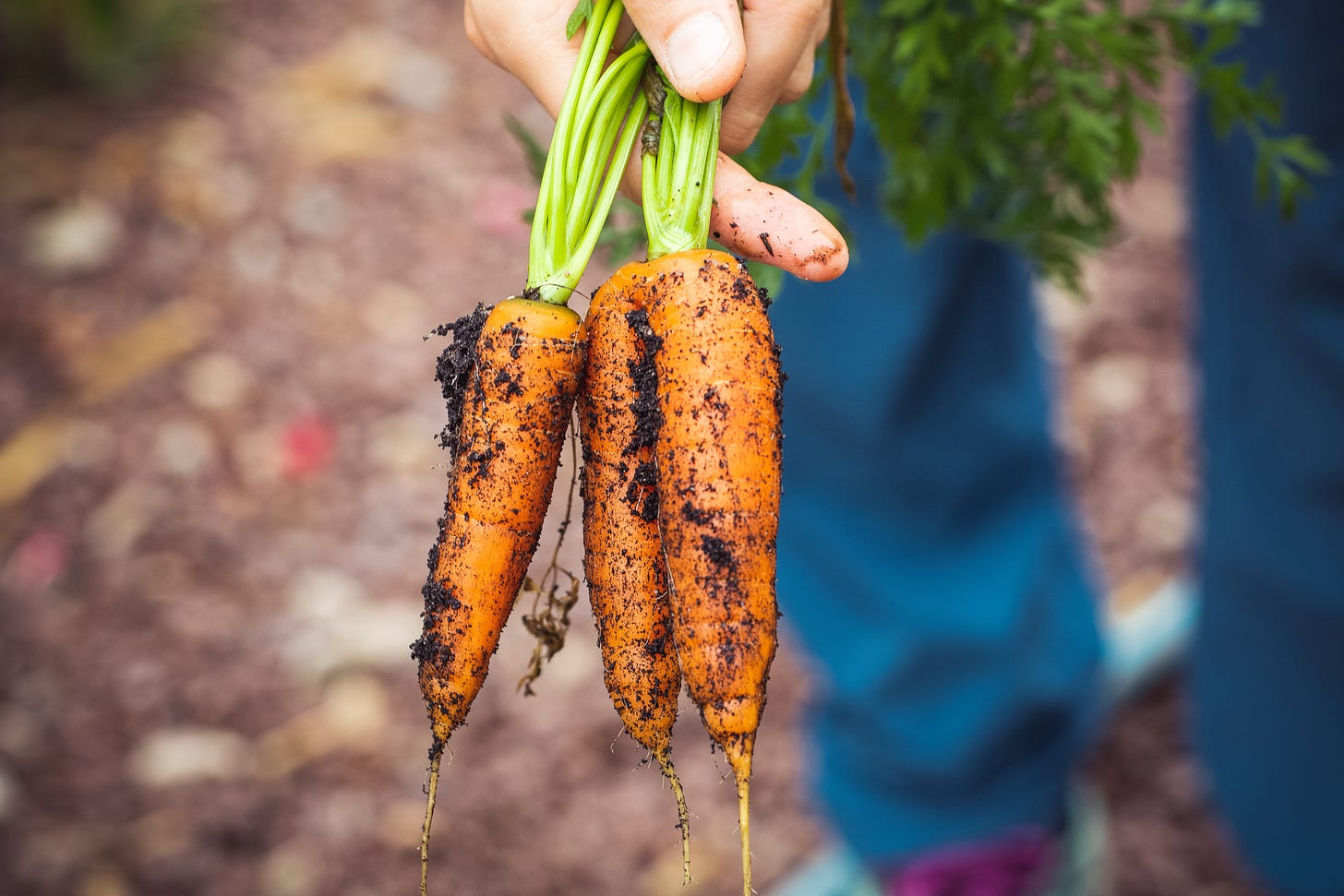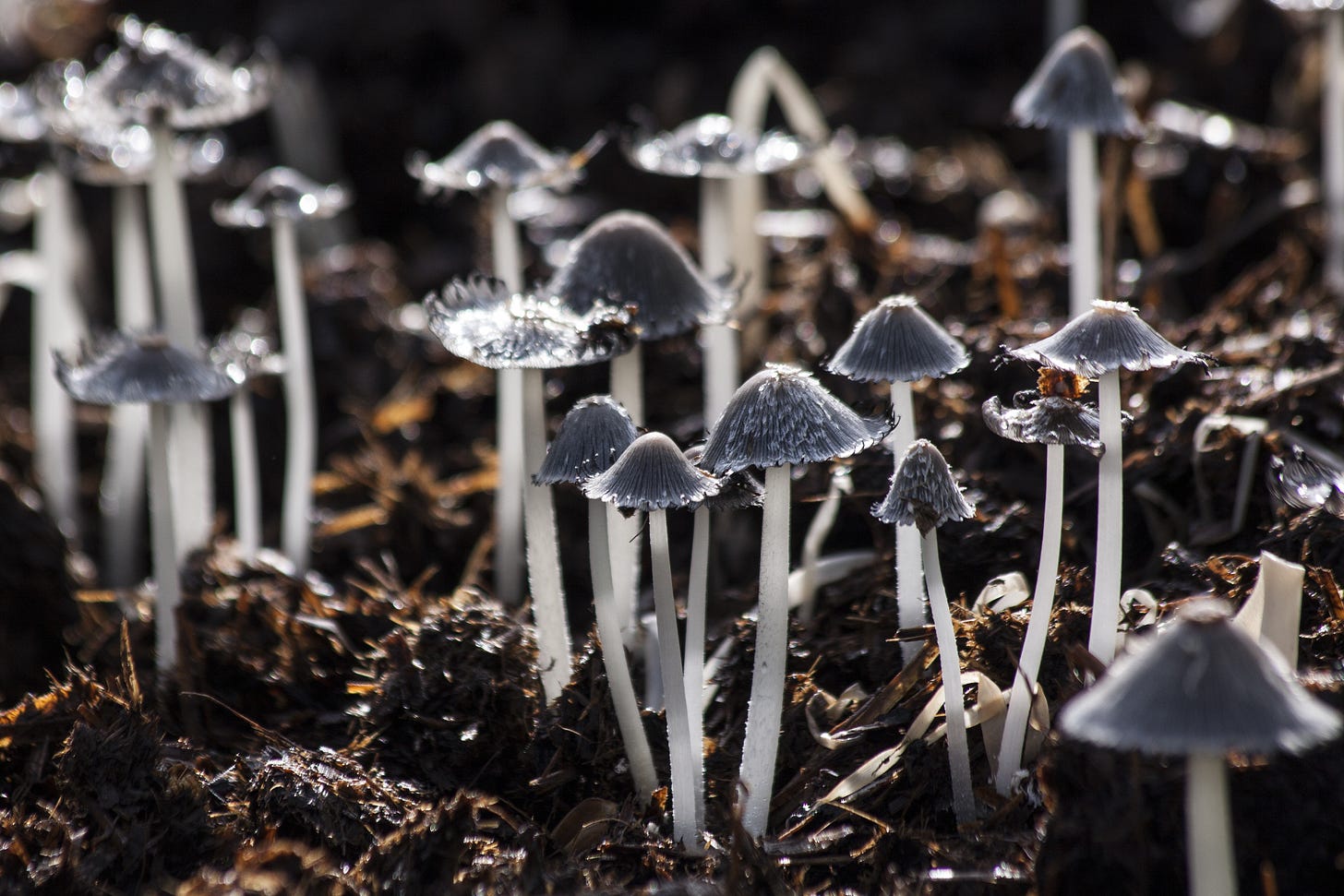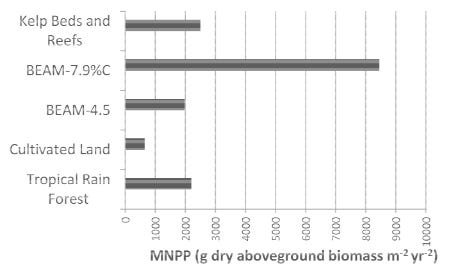Create quality homemade fertilizers based on scientific data, trials and shared experience
The Dutch government is reducing fertilizer emissions by 50% by 2030 and Canada has a similar target of 30% of fertilizer emissions by 2030. This has sparked multiple protests and outrage, which raises production concerns for high intensity crops.
Ignoring the bureaucratic absurdity, are there productive alternatives to traditional chemical fertilizers that have been proven effective?
The continued use of the trope that ‘we will soon need to feed nine billion people’ as justification for seeking ever greater yields is duplicitous.
Hunger and food access are not yield issues.
Regenerative agriculture absolutely can feed the world. And it can do it while stabilizing the climate, regenerating ecosystems, restoring biodiversity, and enhancing rural communities.
— Regenerative Agriculture and the Soil Carbon Solution, Rodale Institute
To understand fertilizers and fertility we must first discuss nutrients.
A nutrient is a substance used by organisms to survive, grow and reproduce.
Nutrients are essential for healthy plant growth.
Plant nutrients are generally found in organic and inorganic matter within the soil. If sufficient nutrients are not returned back to the soil then the next generation may suffer from disease or infestation. A fertilizer is any material applied to the soil or plant material that supplies essential nutrients.
Plant nutrients are organized as:
Primary macronutrients.
Needed in large amounts — N, P, K.Secondary macronutrients.
Needed in lesser amounts — S, Ca, Mg, Si.Micronutrients.
Needed in trace amounts — Fe, Mo, B, Cu, Mn, Na, Zn, Ni, Cl, Co, Al.
NPK is the labelling method that expresses the percentage content of primary macronutrients in a fertilizer.
Each number represents the % amount of nitrogen, phosphorus or potassium respectively.
e.g., 24–6–6 represents 24% N, 6% P and 6% K, which is a 4:1:1 ratio of macronutrients.
What makes organic methods different from inorganic methods?
Organic methods.
Natural biological solutions.Inorganic methods.
Synthetic chemical solutions.
Considering that science and technology can artificially mass produce macronutrients plants need, why would an organic method be preferred over an inorganic method?
The answer is very simple.
By far, nature is the best chemist of all time.
Organic methods recognize that nature is better at sourcing nutrients than any artificial method. By making nutrients bioavailable, plants are naturally supplied the required nutrients when needed and in the correct amounts.
Are there methods to improve bioavailability?
One method is to introduce symbiotic organisms such as mycorrhizal fungi.
These organisms infiltrate a plant’s root system — effectively extending the roots — and are able to transport nutrients found in soils, well outside the normal range of roots, in exchange for sugars exuded by the plant.
Because of these beneficial fungi, organic methods discourage digging and tillage.
(There are a lot of other good reasons not to till as well).
These species of fungi can be inoculated into soils or used during seed germination.
Regenerative Agriculture
Regenerative Agriculture aims to improve soil’s natural ability to function efficiently.
There are seven principles for soil health:
Diversify crop rotation.
Different species have different nutrient requirements.Plant cover crops, green manures and perennials.
Return nutrients to the soil and feed microorganisms.Retain crop residues.
Leave materials post-harvest that will be used as microbial feed.Use natural sources of fertilizer.
Close the nutrient cycle and use bioavailable nutrients.Use highly managed grazing and integrate livestock.
Mimic plant / animal relationships in nature.Reduce tillage frequency and depth.
Avoid damaging fungal growth in the soil.Eliminate synthetic chemicals.
Bioavailable nutrients are less likely to run-off or have negative side-effects.
Are these methods as productive as modern agriculture?

In Development of soil microbial communities for promoting sustainability in agriculture and a global carbon fix by David Johnson et al., the authors conduct a scientific study using what they term the Biologically Enhanced Agricultural Management (BEAM) approach in several field experiments.
The BEAM experiments used:
No synthetic fertilizers, pesticides or deep soil-turning.
As per Regenerative Agriculture principles.Traditional quantities of water.
Water application as per control.Standard agricultural techniques with no specialized equipment.
Methodology as per control.Green manure cover crops.
Nitrogen scavenging and soil root penetration — inter-cropped multi-species for winter and single species for summer.
Inoculated spray of fungal-dominant compost from a Johnson-Su bioreactor.
Application of 0.25 ton / acre to 60% moisture content.
Field trials concluded an increase in:
Carbon sequestration.
Carbon capture in the soil.Nitrogen fixation.
Nitrogen stored in plants and soil biomass.Soil respiration.
Carbon dioxide respiration in the soil.Macro and micronutrient characteristics.
Measured concentrations for a 19 month period to determine various effects.Fungal and bacterial biomass.
Active microbial populations and the ratio of fungus to bacteria (F:B).Plant biomass.
Amount of above ground growth as a yield.
Figure 8 graphs the Mean Net Primary Production (MNPP) of above ground biomass, which represents yield in grams per square meter per year.
This is demonstrable evidence that no-till Regenerative Agriculture using mycorrhizal fungi inoculations has the potential to produce high yields.
Not only are these methods productive, but are sustainable and cheap!
To learn more about BEAM compost:
Please visit beamcompost.com and discover more resources.
Watch how to make your own Fungal Dominant Bioreactor.
(All you need are shredded leaves, water and worms)Watch David Johnson’s 2021 presentation at Soil Stories.
(Warning! It’s really boring and long).
You can easily make your own fungal dominant compost tea at home!
What about the nutrients?
Most nutrients are byproducts from another organism.
What do primary macronutrients do for plants?
Nitrogen (N).
Needed for growing new stems, leaves and chlorophyll for photosynthesis.Phosphorous (P).
Needed for developing flowers, fruits and root systems.Potassium (K).
Helps plants tolerate stress, such as drought.
Natural primary macronurtients mostly come from:
Manure / urine / castings.
e.g., Soiled chicken bedding, bat / seabird guano, vermicompost, etc.Blood / fish / crustaceans.
e.g., Livestock by products, processed fish, etc.Plants / vegetables.
e.g., Vegetable waste, nutrient accumulating plants, etc.
Below is a table listing typical organic fertilizers used before planting crops.
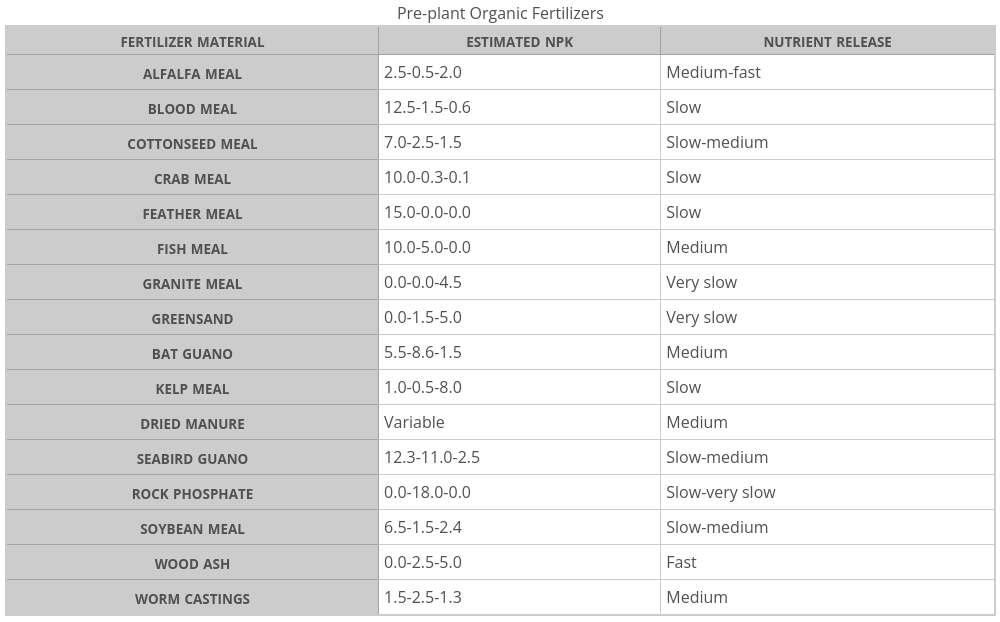
Are there specific plants that can be used as fertilizer or compost ingredients?
The U.S. Department of Agriculture has a public database containing thousands of plants cross-referenced with chemicals called Dr. Duke's Phytochemical and Ethnobotanical Databases. The following screenshots are searches for Nitrogen, Phosphorous and Potassium sorted by High PPM clipped at the first 8 entries.
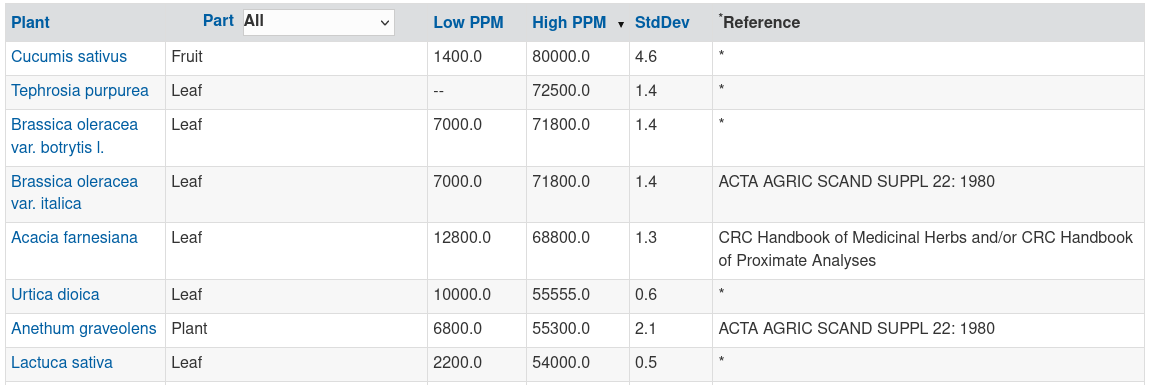
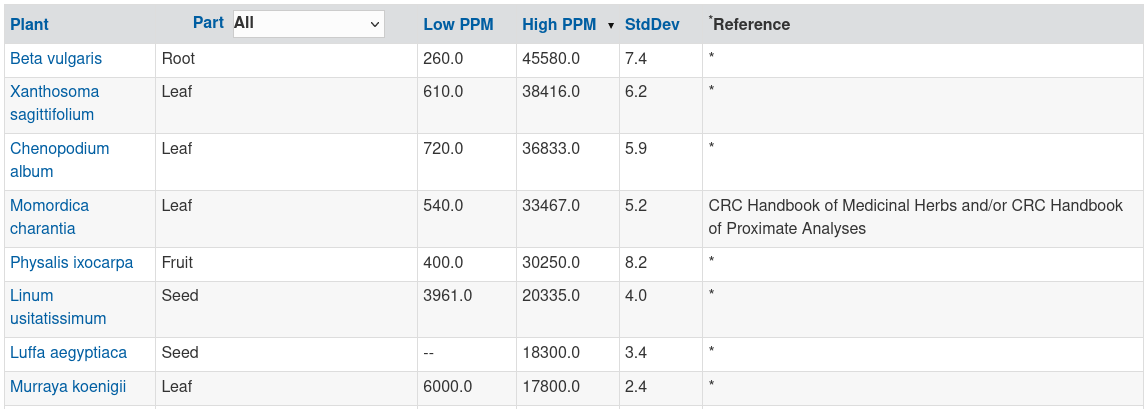

Reviewing the list, some items are traditional human consumable crops or perennials that are more challenging to grow on scale. However, there are three candidates that can be grown in less than ideal soil, with minimal supervision and on scale.
The top picks are:
Stinging Nettle.
(Urtica dioica)
N: {10,000.0 ppm - 55,555.0 ppm}
P: {894.0 ppm - 4,470.0 ppm}
K: {3,500.0 ppm - 17,500.0 ppm}Lambsquarter.
(Chenopodium album)
P: {720.0 ppm - 36,833.0 ppm}
K: {87,100.0 ppm}Sugar Beet Root.
(Beta vulgaris)
N: {2,600.0 ppm - 35,830.0 ppm}
P: {260.0 ppm - 45,580.0 ppm}
K: {3,033.0 ppm - 50,000.0 ppm}
These are often considered weeds.
(With the exception of sugar beet, but it is sometimes used as wildlife feed).
Nutrient accumulating plants can be used as compost ingredients or processed into sprays as described in Appendix A — Creating liquid fertilizers. Note that stinging nettle not a suitable green manure cover crop, because of its perennial tap root.
If there are areas not suitable for quality crop production, they could be cultivated for nutrient production by selectively growing weeds or pioneer species.
Other popular “chop and drop” / compost crops include:
Conclusion
Regenerative Agriculture uses practical and demonstrable methods that produce high organic yields with no artificial fertilizers.
This article discussed three methods, aside from traditional compost, to naturally increase nutrient bioavailability in the soil.
Encourage mycorrhizal fungi growth through inoculations and no-tillage.
Grow winter and summer cover crops as a green manure rotation.
Process animal byproducts and nutrient accumulating plants into nutrient feeds.
By using scientific data, trials and shared experiences, we can design new systems to close nutrient cycles and minimize offsite chemical ingredients.
Since these are natural onsite methods, they could be used to offset chemical fertilizer restrictions, shortages or cost increases. So far there is no regulation or shortage of fungal populations and weeds.
To learn more about Regenerative Agriculture consider these YouTube resources:
Richard Perkins.
Runs Europe's leading Regenerative Agriculture farm and training center.Joel Salatin.
Runs Polyface Farm and is the author of many Regenerative Agriculture books.No-Till Growers.
Runs a commercial market garden and author of The Living Soil Handbook.
Consider growing a “weed garden” this year and creating a shredded leaf bioreactor.
These are great ways to rethink “yard waste” as fertility products!
Appendix A — Creating liquid fertilizers
Organic liquid fertilizers are organized into two groups:
Anaerobic.
Without oxygen.Aerobic.
With oxygen.
JADAM
Anaerobic methods are essentially ferments that soak various nutrient dense materials in water. They may be fermented anywhere from 3 days to 6 months.
Anaerobic methods are very smelly!
The liquid component of the ferment is mixed with a ratio of water, which depends on the length of fermentation, and is directly applied to the soil.
JADAM is a popular organic farming technique that originated from South Korea.
There is a wide variety of JADAM recipes and a book.
Aerobic extract
A less smelly method is an aerobic press that extracts plant liquids. Plants are placed in a breathable vessel and topped with a mass. Gravity slowly presses out the plant’s liquids, which are then captured in a trough.
Aranya from Learn Permaculture demonstrates a low cost liquid plant fertilizer using nettles and comfrey.
Weeds as a resource
Rethink your conviction against weeds as David The Good describes 7 ways to turn weeds into free fertilizer. In addition, I personally suggest intentionally growing specific kinds of weeds that are rich in nutrients. We should envision using regular weeds and intentional weed gardens to collect nutrients for gardens and fields.
Frances Arnold (born Jul. 25, 1956) is an American chemical engineer and Nobel Laureate.



